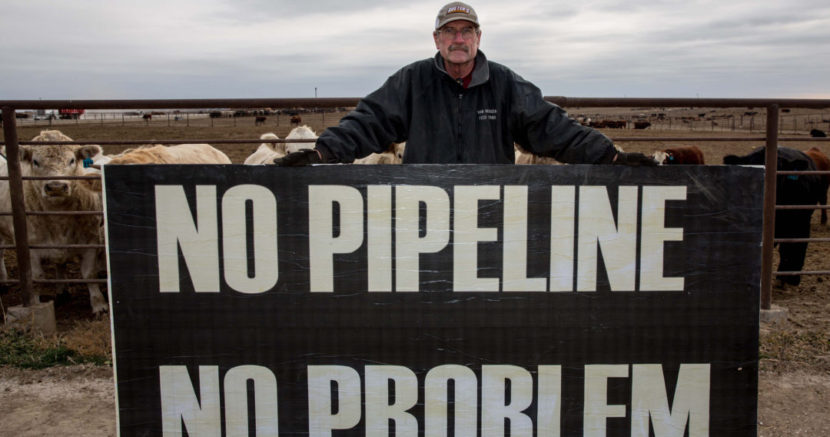

On Jan. 24, President Trump issued a Presidential Memorandum calling for the fast-tracking of completion of the Keystone XL pipeline, and invited TransCanada to resubmit a permit application.
However, this action does not give any “green-light” to start the construction of Keystone XL.
There are still substantial obstacles, and the pipeline is not likely to be built anytime soon.
Jane Kleeb, President of Bold Alliance, said: “Nebraska farmers and ranchers need a President standing up for property rights and our clean water to produce American food. Foreign tarsands pipelines headed to the export market have no place in the Heartland. There is no application for Keystone XL and there never has been an approved route in Nebraska. The President should focus on American energy independence rather than taking land away from farmers using eminent domain for private gain.”
Ken Winston, Bold Alliance lobbyist in Nebraska: “Nebraskans from all walks of life have been willing to stand up to protect land, water and property rights. Farmers, ranchers, grandmothers and Native American leaders are among the many voices raised in opposition to an export pipeline that would risk our most precious resources to benefit a foreign corporation. We will be asking Nebraska elected officials to stand with the people they are supposed to represent.”
STATUS OF KEYSTONE XL:
Nebraska
Unconstitutional pipeline law: The law (LB 1161) governing eminent domain and pipelines that TransCanada directly lobbied to pass through the Nebraska Legislature was challenged in court by Bold and landowners, and found to be unconstitutional. President Obama’s rejection of the pipeline compelled a Nebraska judge to dismiss the landowners’ case, but the unconstitutional law LB 1161 remains on the books, and thus TransCanada’s route for Keystone XL approved under the law is void. As a reminder, this law was pushed by Sen. Jim Smith, chair of Koch brothers-funded, right-wing group ALEC, which always does the bidding of corporations.
TransCanada must apply with Public Service Commission: Faced with this unconstitutional law they pressured Nebraska lawmakers to pass, TransCanada must instead now submit an application to build Keystone XL through Nebraska via the state’s Public Service Commission — a process that can take 8 months to a year. The PSC always had the constitutional authority to review pipelines, and during the heated 2011 Special Session in the Nebraska Legislature the PSC was given guidelines for reviewing pipelines. The PSC has the authority to tell TransCanada to choose a different route (e.g. Place a second pipeline alongside the Keystone 1 pipeline using the existing easements, so as to not take more land out production, and to not touch the fragile Sandhills and shallow parts of the Ogallala Aquifer). The PSC can also deny TransCanada’s application for a permit altogether.
No eminent domain for TransCanada until September 2017: TransCanada cannot apply to use eminent domain authority again to take farmers’ and ranchers’ land against their will until September 2017, according to applicable Nebraska state law governing the use of eminent domain. The collective of Nebraska landowners who held out against selling their land to TransCanada remains strong — many are still in court suing TransCanada for the money they had to spend on attorneys and court costs battling eminent domain for over six years.
South Dakota
The proposed Keystone XL route runs near the Rosebud and Pine Ridge Reservations and through their traditional Tribal territories. These Sioux reservations, like Standing Rock in North Dakota, are part of the Oceti Sakowin (Great Sioux Nation) and are likely to convene large numbers of Water Protectors from all over the country. The Tribes have strong legal claims relating to the failure of TransCanada and federal agencies to properly study the route, and consult with the tribes.
Federal Clean Water Act Permits still required
While some of these actions will eliminate claims under the National Environmental Policy Act (NEPA), Keystone XL will still be required to secure Section 404 Clean Water Act (CWA) permits for wetlands and stream crossings, absent Congress passing a law specifically exempting Keystone XL from the Clean Water Act. These CWA permits are subject to environmental review, and can be legally challenged.
Alberta, Canada and Commercial Considerations
When Keystone XL was first proposed in 2008 and again in 2011, oil prices were high ($100+ / barrel) and the tarsands industry in Alberta was expanding rapidly. Since then, oil prices have collapsed ($53 today). While projects that were already under construction when prices collapsed are being completed, all new projects are stalled. Tarsands reserves are marginal, and some companies may have to write down their tarsands assets.
In addition, the Alberta Government has committed to a cap on emissions from tarsands production. That cap, at 100m Metric tons of carbon, is roughly equivalent to 3.2 MBD of production. Increased efficiency could raise that production level in theory, but it would also raise the cost of the production. So even if oil prices recover, the tarsands industry will never go back to the unfettered growth of earlier periods.
In addition, since Enbridge has expanded its network of tarsands pipelines through the Midwest, so that some tarsands crude is now reaching the Gulf Coast. Finally, the Kinder Morgan Trans Mountain pipeline to the Vancouver coast has received Canadian federal approval — though opposition in British Columbia is quite strong, and that pipeline is not a done deal.
While TransCanada does have approved routes through Montana and South Dakota, it no longer has shipper agreements with tarsands crude producers. It is not clear that there is any need at all for an additional pipeline, for an industry that has a great deal of pipeline capacity already, and is not likely to grow.
Trump’s Statements
Finally, there are Donald Trump’s cryptic statements about wanting the U.S. to share in the profits from KXL, possibly via a 25% tax. This perspective is completely outside the norm for pipelines and, if implemented, could put TransCanada and its shippers at an economic disadvantage against other pipeline projects. Given all the other commercial weaknesses, this could cause TransCanada and Canadian oil producers to de-prioritize the project.
More Background on Nebraska
The Nebraska Legislature passed Legislative Bill 1 and 4 (LB 1 and LB 4) in 2011. LB 1 established the Major Oil Pipeline Siting Act, which required the Nebraska Public Service Commission to approve pipeline routes before the right of eminent domain could be exercised and construction could begin. LB 1 and LB 4 set out an approval process that included public hearings and environmental reviews. Following the second KXL application in 2012, the legislature passed LB 1161 which gave pipeline applicants the choice between applying to the PSC; or applying directly to the governor for approval of pipeline routes and eminent domain authority (thus circumventing the PSC process altogether). Governor Heineman subsequently approved the KXL route using LB 1161 process.
In 2014, a district court in NE ruled in favor of landowners and declared LB 1161 unconstitutional and void because it improperly gave the governor authority over pipeline approval. In January 2015, the Supreme Court reversed the lower court ruling because only four out of seven judges found LB 1161 unconstitutional (one vote short of the five required for constitutional issues). The three dissenting judges declined to address the constitutionality of LB 1161, instead finding the landowners lacked standing as taxpayers. However, every judge to weigh in on the issue has found LB 1161 unconstitutional.
After TransCanada later initiated condemnation proceedings, about 70 landowners re-filed challenges to LB 1161, and a judge granted an injunction halting the eminent domain process. All of TransCanada’s eminent domain proceedings in Nebraska were put on hold, while the constitutional challenges made their way back up to the Nebraska Supreme Court.
In September 2015, TransCanada shifted strategies by withdrawing from the Nebraska lawsuit and instead filing an application with the PSC. However, after the Obama Administration rejected the Keystone XL presidential permit several months later on Nov. 6, 2015, TransCanada withdrew its Keystone XL application to the Nebraska PSC.
An ongoing mystery is why TransCanada never “twinned” Keystone XL with Keystone 1 for the several hundred miles of route through Nebraska — using the existing easements negotiated with landowners to place the pipeline on the same parcels of land.
One theory is TransCanada wanted to place a second pipeline next to Keystone 1 — as well as Keystone XL — so they would have four pipelines, instead of two. However, with the collapse of oil prices, that scenario is unlikely.
TransCanada’s route through Nebraska remains illogical, risky and a major obstacle to the building of Keystone XL.



